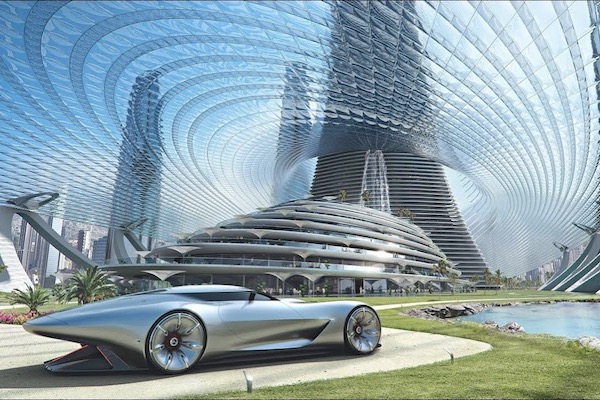Published on the 19/09/2024 | Written by Heather Wright

A new automated reality…
“The future of ERP is exciting – I promise!”
Neha Ralhan, Gartner senior principal analyst, who covers ERP and composable ERP strategies, is fired up about the future of ERP.
While she stops short of calling the changes the ERP market is undergoing ‘game-changing’ she says it is a seismic shift, and one that sees ERP finally coming to the party with a lot of things we take for granted in other parts of the tech-sphere coming to the ERP experience.
“You will need to bring a different spirit this time around as ERP evolves into its next iteration.”
Speaking at the recent Gartner IT Symposium/Xpo, Ralhan outlined a vision for the future of ERP and the four key elements – adaptive experience, embedded intelligence, autonomous orchestration and composable – which will provide users with a more intelligent, meaningful experience.
Those four elements also map perfectly to the four elements in the future of the wider enterprise applications market, she notes.
“The future of ERP is more than a technology repair, replacement, renovation and it is not even a technology upgrade. And that’s because there are no shortcuts to evolution.
“You as CIOs and tech leaders will need to bring a different spirit this time around as ERP evolves into its next iteration.”
Gartner figures show an ‘eye-watering’ 70 percent of ERP leaders across industries plan to replace or upgrade at least one packaged application solution in the next 12-24 months.
While that figure is from a global survey, Ralhan told iStart that based on anecdotal evidence she believes Australia and New Zealand are on par.
“Right now ERP is still seen as a product that is heavily focused on core operations and finance.
However, you may have noticed that increasingly the financial aspect planning of ERP is being picked up by other niche vendors and satellite solutions.”
As a result, the ERP space is having to defend itself and that’s coming in the form of innovation around core operations.
“This provides a fantastic opportunity for organisation to renew and transform their core operational capabilities because all the innovation is being done to ensure an automated new reality.”
Unsurprisingly, AI is at the forefront of changes, influencing and disrupting enterprise applications and changing the way those applications are used and consumed.
“It’s teaching us to consume applications in a brand new way,” she says, comparing it to the move from wired to wireless headphones.
The first of the four elements reshaping ERP is adaptive experience, which includes conversational AI, voice and persona-based interactions which go beyond the current ‘relatively crude’ options to more individual personas, and will evaluate context.
While they aren’t new capabilities, Ralhan says the difference now is their maturity and integration into existing packages, without the need to create from scratch.
“It’s about ensuring people have meaningful, intelligent experiences with their ERP and ensuring friction is reduced. Then over time it adapts to our individual style, and it will be context-rich or persona-rich.
“In a lot of ways, we already have this in other parts of our technology, but in ERP it is not as prevalent. That will change,” she says.
“This isn’t just about conversational AI, it’s also about merging persona-based experience, it’s about voice, it’s about finally meeting the end-users of ERP where they are.”
The second element is embedded intelligence. Early-stage features are already being added into ERP, but Ralhan says this will become all-encompassing and end-users ultimately won’t recognise what is an AI generated insight or AI-powered operation – and organisations’ won’t care.
Information across multiple systems – CRM, finance, HCM and others – will be collected and used to deliver ready-made, in-depth and, critically, accurate, insights.
“That’s not happening today because data models across the applications are not the same, so you’re often comparing apples and oranges, and also because GenAI modelling is still not ready to deliver this capacity with the level of accuracy required,” she says, noting the ongoing issue of hallucinations.
It’s the third element – autonomous orchestration – however, that Ralhan holds up as her favourite and the one without which adaptive experience and embedded intelligence would not be possible.
“At the moment so much of ERP can be siloed and orchestration brings it together and gives it a holistic 360-degree view,” she says.
“Without robust and efficient orchestration you can’t have end to end processes.”
She cautions organisations to be wary when vendors tell them that’s a capability their ERP offering already has.
“Just double check it’s not RPA.
“Currently we see a lot of RPA being delivered within the ERP. But RPA only allows for a repetitive use case for an end-to-end process and when there is an anomaly in the pathway, it doesn’t hold up very well.”
As AI engines become more prevalent, orchestration will become more robust between processes and different technologies, applications and data models.
“Customers will want orchestration that will also work on a composable application strategy. This means is that there will be multiple applications involved from very large enterprise-wide apps to teeny tiny APIs that are all part of your landscape,” she says.
“Orchestration connects the dots and bridges the gaps. That’s why it’s the most pragmatic of the elements.”
It will also replace, or at least supplement, so of the ERP design currently required.
Rounding out the four elements is composable architecture, which assumes you’re being application agnostic in solving mission critical requirements, with a common vendor-delivered core surrounded by agnostic, non-core offerings.
But composability, for all the talk, is a vision she admits is currently falling short. A recent Gartner survey found 50 percent of respondents had a single vendor, monolithic approach and of those, 60 percent said they had no plans to change in the near future.
“A composable architecture will help deliver the core and non-core capabilities that are custom and specific to your organisation,” she says.
“Ideally over time with composability you can reduce your dependence on a particular vendor because you begin to independently deliver them. But you have to own the story and build a defensible narrative around it.”
Ralhan says the future of ERP focuses on a build and buy approach akin to the experience we already have from the likes of the iPhone – we all have a common operating system, but our experience differs vastly depending on the apps we download from the app store – and ensures it is underpinned by composabilty.
Many of the features across the four areas will be hand delivered to users via SaaS-based ERP.
“In the medium to long term, we are moving away from single vendor, single app approach to multi-vendor multi-application approach. There will be more of a focus on custom UX with different persona’s to create intelligent and meaningful experiences. Automation will be wide ranging and working across different applications, technologies, processes and data models and all of this will be underpinned by composability.
“In other words, we are moving away from a monolithic approach to an automated headless and touchless ERP.”
She notes not all aspects of the four elements will be relevant to every organisation.
As to her advice on making the move, she stresses the importance of engaging with the business and creating a dynamic strategy which can adapt and be flexible as the market and your organisation change.
“And always ensure business value is your guiding light, your north star.”



























